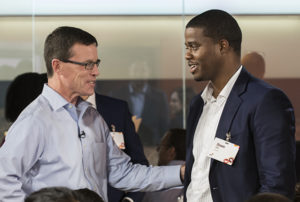Taking Action on Diversity and Inclusion

Tim Ryan ’88 is many things. He is a certified public accountant and a proud father. He is the U.S. chair and senior partner at professional-services firm PwC, and he is one of the leading executives on diversity and inclusion in corporate America.
Above all else, though, Ryan is an entrepreneur at heart. As a Babson-educated entrepreneurial leader, he excels at not only identifying problems but also mobilizing people and resources to find solutions and implement actions.
Nowhere is that more obvious and more relevant than on diversity and inclusion. Since 2016, Ryan has sought solutions and taken action, not only leading PwC’s continuing journey to improve opportunities for everyone but also leading other executives through CEO Action for Diversity & Inclusion.
Last summer, Ryan’s leadership—in the aftermath of the tragic events that sparked protests and discussions on racial injustice—culminated in PwC releasing its first diversity and inclusion transparency report, titled “Building on a Culture of Belonging.” It was a critical step in the company’s ongoing diversity journey and a beacon for other organizations seeking change.
“Ultimately, what I want to create is a place where anybody can succeed if they’re willing to put in the work, no matter who you are,” Ryan said.
‘Mass Understanding’
Last year was a turning point. “It’s clear as day the world pivoted after George Floyd’s murder Memorial Day weekend,” Ryan said.
For Ryan and PwC, though, the pivot point was in 2016, a summer when another string of racially motivated violence shook the country. In response, Ryan listened and responded. Only days into his tenure as U.S. chair, he started a discussion on race among PwC’s 50,000 employees, and he co-founded CEO Action for Diversity & Inclusion, enlisting fellow executives to join forces to effect change.
In 2020, as the nation roiled and protests raged, more and more people and companies were beginning their own conversations on race, finally confronting the problems of racial injustice head on.
“What I was encouraged by after George Floyd’s killing was we had this mass understanding, understanding at scale, of what the challenges that our Black colleagues have,” Ryan said.
“After a horrible, tragic event, I’m encouraged that we’re going to have a big growth spurt in inclusion across our country.”
Tim Ryan ’88, U.S. chair and senior partner, PwC
Since that moment, Ryan has spoken to more than 400 CEOs. In almost all of those conversations, business leaders are asking themselves and each other a host of questions: What are you doing? How can we do better? How can we learn from each other? What could I be doing better? That collective recognition and self-assessment is a critical step in addressing the problems of racial inequality.
“After a horrible, tragic event, I’m encouraged that we’re going to have a big growth spurt in inclusion across our country,” Ryan said, “and I think the best way we can honor George Floyd, and so many people like him, is to take advantage of this mass understanding to all get better.”
Importance of Transparency
PwC has been trying to get better for the past quarter-century. Its first diversity and inclusion report, released in August, was just the latest step in its journey, and it was the result of a strategic decision in that pivotal summer of 2016.

In one of his first actions as U.S. chair at PwC, Tim Ryan ’88 encouraged and fostered discussion among the company’s 50,000 employees.
“We believe transparency plays an important role in becoming a truly inclusive organization,” Ryan said, “and so what we produced in August was four years in the making.”
During that time, PwC identified more than 150 metrics related to diversity and inclusion. In analyzing what was important to the company, its employees, and its clients, PwC settled on 14 critical benchmarks to include in its first diversity and inclusion report. For Ryan, though, more important than the score on any one of those metrics was the act of transparency itself and the bigger picture that it revealed.
“Without a doubt, the biggest lesson to learn for us was that nobody’s numbers are where we want them to be,” he said. “Ultimately, we believed that was an important step in the strategy, because, number one, hopefully we inspire others to be transparent. And, number two, it gives us that self-imposed pressure to do better.”
Taking Action
As an entrepreneurial leader, Ryan knows all about doing better. Taking the first step. Collecting data. Reiterating. Taking the next step. It’s an entrepreneurial process.
“Without a doubt, I learned about entrepreneurship at Babson,” Ryan said. “You need to take a chance, you need to follow your instinct, you need to do work, as we learned at Babson.”
WATCH: Babson students lead peaceful protest against social injustice.
When Ryan began planning CEO Action for Diversity & Inclusion in 2016, experts told him he should be happy to enlist 20 companies. When it launched in June 2017, there were 112. Today, there are more than 1,400, representing more than 20 million employees in the United States. Last summer, Ryan led the launch of CEO Action for Racial Equity to mobilize those companies to help enact change through public policy.
“Without a doubt, this ties back to my entrepreneurial roots,” Ryan said. “CEO Action is a startup, and now it’s a startup that has 1,400 members, there’s over 1,000 best practices on the website. And, it’s making a massive, massive impact on society.
“I think there’s a clear tie back to entrepreneurship,” he said, “and it’s been very gratifying to have a startup entity within my career, so I’m really excited about that.”
Posted in Entrepreneurial Leadership, Insights






